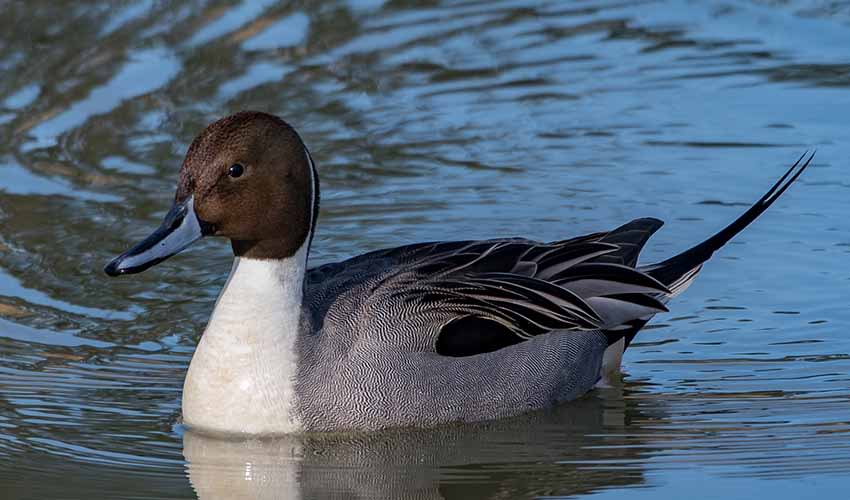One of the most elegant ducks in the world, often admired for its graceful shape and sleek plumage. Males are especially striking during the breeding season, with long, pointed tail feathers that can stretch up to four inches—hence the name “pintail.” Their chocolate-brown heads contrast beautifully with their white necks and gray bodies, giving them a refined, almost aristocratic look. Females, though more modest in coloring with mottled brown feathers, share the same slender, elongated body that sets pintails apart from bulkier ducks. Their long necks and slim profiles make them resemble small geese gliding over the water. Watching a pintail take flight is like watching poetry in motion—their wings beat rapidly, and they rise smoothly into the air with impressive speed and agility.
These ducks are found across the Northern Hemisphere, from the icy tundras of Alaska to the wetlands of Asia and Europe. They are true travelers of the bird world, migrating thousands of miles between breeding and wintering grounds. Some pintails have been known to travel from Canada all the way to Central America during migration season. Despite their long journeys, they always find their way back to familiar nesting areas, guided by instincts scientists still don’t fully understand. Their nests are often placed in grassy fields or tundra near water—sometimes even miles away from the nearest pond—showing their confidence and adaptability to different landscapes.
Unlike some other ducks that quack noisily, pintails are relatively quiet. Males make soft, whistling calls, while females produce a low, coarse “quack,” making them one of the more understated species on the pond. Interestingly, pintails are among the first ducks to migrate in both spring and fall, earning them the nickname “harbingers of migration” among birdwatchers.
Distribution
 Afghanistan
Afghanistan Albania
Albania Algeria
Algeria Anguilla
Anguilla Antigua & Barbuda
Antigua & Barbuda Armenia
Armenia Aruba
Aruba Australia
Australia Austria
Austria Azerbaijan
Azerbaijan Bahamas
Bahamas Bahrain
Bahrain Bangladesh
Bangladesh Barbados
Barbados Belarus
Belarus Belgium
Belgium Belize
Belize Benin
Benin Bermuda
Bermuda Bhutan
Bhutan Bosnia And Herz.
Bosnia And Herz. Botswana
Botswana Brazil
Brazil British Virgin Is.
British Virgin Is. Brunei
Brunei Bulgaria
Bulgaria Burkina Faso
Burkina Faso Burundi
Burundi Cambodia
Cambodia Cameroon
Cameroon Canada
Canada Cayman Islands
Cayman Islands Central Af. Rep.
Central Af. Rep. Chad
Chad China
China Colombia
Colombia Cook Islands
Cook Islands Costa Rica
Costa Rica Croatia
Croatia Cuba
Cuba Cyprus
Cyprus Czechia
Czechia Côte D’ivoire
Côte D’ivoire DR Congo (Kinshasa)
DR Congo (Kinshasa) Denmark
Denmark Djibouti
Djibouti Dominica
Dominica Dominican Republic
Dominican Republic Egypt
Egypt El Salvador
El Salvador Eritrea
Eritrea Estonia
Estonia Ethiopia
Ethiopia Faroe Islands
Faroe Islands Finland
Finland France
France French Polynesia
French Polynesia Gabon
Gabon Gambia
Gambia Georgia
Georgia Germany
Germany Ghana
Ghana Greece
Greece Greenland
Greenland Guadeloupe
Guadeloupe Guam
Guam Guatemala
Guatemala Guinea-Bissau
Guinea-Bissau Guinea
Guinea Guyana
Guyana Haiti
Haiti Honduras
Honduras Hong Kong
Hong Kong Hungary
Hungary Iceland
Iceland India
India Indonesia
Indonesia Iran
Iran Iraq
Iraq Ireland
Ireland Israel
Israel Italy
Italy Jamaica
Jamaica Japan
Japan Jordan
Jordan Kazakhstan
Kazakhstan Kenya
Kenya Kiribati
Kiribati Korea
Korea Kuwait
Kuwait Kyrgyzstan
Kyrgyzstan Laos
Laos Latvia
Latvia Lebanon
Lebanon Liberia
Liberia Libya
Libya Liechtenstein
Liechtenstein Lithuania
Lithuania Luxembourg
Luxembourg Malawi
Malawi Malaysia
Malaysia Maldives
Maldives Mali
Mali Malta
Malta Marshall Islands
Marshall Islands Martinique
Martinique Mauritania
Mauritania Mexico
Mexico Micronesia
Micronesia Mongolia
Mongolia Montenegro
Montenegro Montserrat
Montserrat Morocco
Morocco Myanmar
Myanmar Nepal
Nepal Netherlands
Netherlands Nicaragua
Nicaragua Niger
Niger Nigeria
Nigeria Nort. Mariana Is.
Nort. Mariana Is. North Korea
North Korea North Macedonia
North Macedonia Norway
Norway Oman
Oman Pakistan
Pakistan Palau
Palau Panama
Panama Papua New Guinea
Papua New Guinea Philippines
Philippines Poland
Poland Portugal
Portugal Puerto Rico
Puerto Rico Qatar
Qatar Romania
Romania Russia
Russia Rwanda
Rwanda Saint Barthélemy
Saint Barthélemy Saint Lucia
Saint Lucia Saint Pierre
Saint Pierre Saint Vincent
Saint Vincent Saudi Arabia
Saudi Arabia Senegal
Senegal Serbia
Serbia Seychelles
Seychelles Sierra Leone
Sierra Leone Singapore
Singapore Slovakia
Slovakia Slovenia
Slovenia Somalia
Somalia South Africa
South Africa South Sudan
South Sudan Spain
Spain Sri Lanka
Sri Lanka St. Kitts & Nevis
St. Kitts & Nevis Sudan
Sudan Suriname
Suriname Svalbard
Svalbard Sweden
Sweden Switzerland
Switzerland Syria
Syria Taiwan
Taiwan Tajikistan
Tajikistan Tanzania
Tanzania Thailand
Thailand Togo
Togo Tonga
Tonga Trinidad & Tobago
Trinidad & Tobago Tunisia
Tunisia Turkmenistan
Turkmenistan Turks & Caicos
Turks & Caicos Turkey
Turkey UAE
UAE US Minor Is.
US Minor Is. US Virgin Islands
US Virgin Islands Uganda
Uganda Ukraine
Ukraine United Kingdom
United Kingdom United States
United States Uzbekistan
Uzbekistan Venezuela
Venezuela Vietnam
Vietnam Yemen
Yemen Zambia
Zambia Zimbabwe
ZimbabweAnything we've missed?
Help us improve this page by suggesting edits. Glory never dies!
Suggest an editGet to know me
Terrestrial / Aquatic
Altricial / Precocial
Polygamous / Monogamous
Dimorphic (size) / Monomorphic
Active: Diurnal / Nocturnal
Social behavior: Solitary / Pack / Herd
Diet: Carnivore / Herbivore / Omnivore / Piscivorous / Insectivore
Migratory: Yes / No
Domesticated: Yes / No
Dangerous: Yes / No




